—The material culture of science was substantially transformed in the nineteenth century, a process in which the new instrument production industry played a key role.—
The material culture of science, in particular scientific instruments, underwent a major transformation during the nineteenth century. In the field of chemistry, the mass arrival of glass objects allowed designs to be more suited to particular needs. By learning a series of glass working techniques, people trained in chemistry or pharmacy, often with the help of specialised artisans, were able to design appliances to be used in multiple ways, for example, within chemical analysis. Analysis through chemical testing was developed to respond to requests from courts, municipalities and governments on matters related to poisoning, food adulteration, access to drinking water and, generally speaking, the quality control of a large number of products. An example of the new glass instruments that revolutionised chemical analysis procedures was the arsenic test introduced in 1836 by James Marsh (1794-1846), a co-worker of Michel Faraday at the Royal Institution in London. It could detect tiny quantities of arsenic, the main poison used for criminal purposes during the nineteenth century. Marsh’s essay was adapted for numerous uses outside this field. A large number of models were designed, each intended to solve several problems. Its extreme sensitivity allowed the poisoning cases that had gone unnoticed with the previous methods to be investigated. It also introduced the need for a new pure culture to avoid false positives, which were more likely as the technique became more sensitive and allowed the detection of smaller amounts of poison. All this led to numerous paradoxes, fallacies and controversies that shaped the image of expert knowledge in nineteenth-century courts.
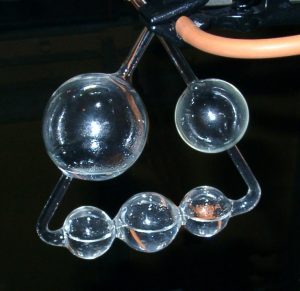
Kaliapparat by Justus Liebig in a modern version produced for the Liebig-Museum, Gießen. It enables the carbon dioxide formed by the combustion of the organic product being analysed to be collected and its composition to be calculated. Wikimedia.
Another glass instrument, which was also decisive in revolutionising chemical analysis, was the Kaliapparat, introduced by Justus Liebig (1803-1873) in his pioneering studies on organic chemistry in the 1830s. It provided a standardised method for measuring the quantities of the most important organic elements: carbon, oxygen and hydrogen. From this quantitative data, more or less replicable and comparable, and with some creative imagination, it was possible to establish new chemical formulas for many organic compounds, without avoiding uncertainties and controversies. Like Marsh’s test, the Kaliapparat was a seemingly simple method that did not involve great economic investments in materials and products, although it did require solid training in laboratory techniques. Through personal contacts, or through the guide developed by Liebig, the Kaliapparat travelled surprisingly quickly around the world. It was proved to be flexible enough to adapt to diverse situations without losing its identity as a chemistry instrument. Nonetheless, its circulation was also surrounded by controversy and there were numerous problems with its replication. An American research team, led by the historians Mel Usselman and Alan Rocke, replicated Liebig’s experiments with the Kaliapparat at the beginning of the twenty-first century. They faced many difficulties to replicate the expected results, due to both the chemicals and the materials used, and the physical techniques involved. It is also true that the replication of results was satisfactory in many cases, which seems to prove the potential capacity for circulation of this instrument, as can be seen in nineteenth-century sources. When it was replaced by other analytical instruments in academic and industrial laboratories in the twentieth century, the Kaliapparat continued its journey through chemistry classrooms, in the form of laboratory practices, written exercises and assessment tests, all while its stereotypical image became a symbol for some powerful academic societies.
Replication problems have been even greater when it comes to other nineteenth-century experiments, such as Coulomb’s torsion balance, intended to calculate the force of attraction between electric charges, or Joule’s apparatus, designed to demonstrate the identity of heat and the mechanical work. In the two latter cases, and in many others, historical research has come to the conclusion that, besides the difficulty of finding materials and products from the time, it is necessary to gain tacit and embodied knowledge, as well as practical skills and laboratory techniques, in order to properly use these devices (or, at least, use them as the historical actors did). Despite these problems, some instruments used in physics, such as Joule’s apparatus, were the basis for some of the most important research of the nineteenth century, for example, that related to the conversion of different types of energy, or the establishment of conservation principles that would be the basis of the new thermodynamics.
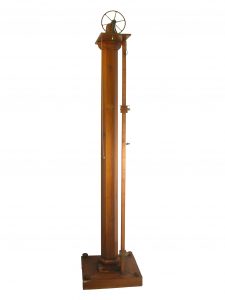
Late 19th century Atwood machine from the collection of the F. Ribalta Secondary School in Castellón. COMIC. Comisión de Instrumentos. Científicos.
Other instruments were used in a more educational context in order to ‘prove’ laws of physics, such as those related to falling bodies that could be seen with Atwood’s famous machine (1745-1807). It was introduced at the end of the eighteenth century as an instrument for public demonstration to defend Newtonian philosophy against approaches inspired by Gottfried Leibniz’s work and his idea of ‘vis viva’. These opposing interpretations gave rise to experiments such as those of Willem Jacob’s Gravesande (1688-1742) who used clay and wax to study the impacts of bodies in free fall, and thus his results seemed to reinforce Leibniz’s approaches. Atwood’s machine, on the contrary, gathered together Newtonian approaches and allowed the experiment to be reproduced in public demonstrations to transform it into a source of entertainment and scholarly conversation for Newtonian philosophy. In the hands of the instrument makers of the first half of the nineteenth century, the Atwood machine was transformed into an educational tool for the official education in the new secondary schools. After forgetting the controversy in which it was born, the Atwood machine became a sort of “reified theorem”, an expression attributed to the French philosopher Gaston Bachelard, who had to deal with many others in his work as secondary school teacher during the first half of the twentieth century. As happened with the Kaliapparat, the Volta-type eudiometer or the Atwood machine, many of these three-dimensional objects disappeared from classrooms in the second half of the twentieth century to give way to standard problems with mathematical solutions and without experimentation. This has become the basis of the exams in science classrooms from the nineteenth century to nowadays, as Thomas S. Kuhn has already pointed out in his works.
Another important change in the nineteenth century was the birth of a genuine instrument production industry, for both demonstration and precision. With its roots in the eighteenth century, a great European instrument production industry emerged during the second half of the nineteenth century which would last for almost all the twentieth century. Some of these manufacturers began in the first half of the century in France from craft workshops such as those of Pixii, Dumotiez, Lerebours and Secretan, more or less connected with the academic world. Some of them were later transformed into industries providing scientific material throughout Europe, both for schools and research centres. Many of these industries gained great renown in what is often called the ‘golden age’ of scientific instruments: Henri Soleil, Leon Laurent, Emile Deyrolle (specialising in collections of anatomy and natural history) in France; Max Kohl, Ernest Leybold, Fritz Köhler, or Florenz Sartorius (specialising in precision scales) or the Irish firm Grubb, which became famous for its astronomical precision instruments.
Some of the previous instrument manufacturers, for example Pixii, Lerebours or Kohl, inundated teaching establishments with devices that produced surprising and spectacular phenomena, similar to those carried by eighteenth-century demonstrators, such as George Atwood or François Bienvenu, mentioned above and in another section. It is worth remembering that these demonstrators, to the delight of their audiences, used new instruments from pneumatic chemistry and frictional electrical instruments, that preceded the arrival of Volta’s battery. Impressive public demonstrations did not disappear in the nineteenth century, but coexisted with many other types of experiments, in the area of museums, athenaeums and public sessions. In these spaces, a material culture of its own was developed, which was more or less connected to the existing one in research laboratories, science classrooms or large industries, as will be seen in the following example.
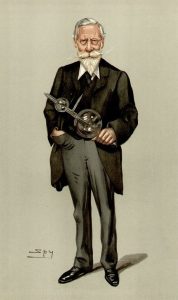
William Crookes pictured in 1902 in Vanity Fair magazine with one of his discharge tubes. Wikimedia.
At the end of the nineteenth century, one of the most surprising phenomena was produced in the discharge tubes of William Crookes (1832-1919). Small quantities of various gases were placed in these tubes and a high voltage current was passed through. Surprising lights and colours were observed that were related to a potential fourth state of matter that was for some time called ‘radiant matter’. Some people from inside and outside the academic world even associated them with phenomena related to spiritualism, an issue that attracted the attention of audiences at the end of the nineteenth century. Crookes himself embarked himself on trying to research the phenomena of spiritualism from the phenomena observed in his instruments. He was not the only person in the academic world who did so. At the end of the nineteenth century, and following a trend in previous decades, there were frequent interactions between academic science and what would now be called ‘occult sciences’. All this produced a great number of more or less surprising and controversial situations that, on many occasions, revealed the instability of the borders of legitimate science. Crookes tubes circulated through this delicate area that connected the diverse cultures of experimentation, marked by diverse purposes, techniques, practitioners and target audiences. In this way, while used to animate the debates about the fourth state of matter and its connections with the afterlife, an apparatus such as Crookes tube could also be used as a starting point for experimental research that would lead to the work of Joseph J. Thomson (1856-1940) on electrical charges, eventually considered to be crucial for the discovery of the first subatomic particle: the electron. Of course, this research was also surrounded by uncertainties, within a wide margin of interpretative flexibility, so the process was much more complex than it is described in linear narratives and retrospective looks, so frequent in science manuals when it comes to the history of atomic theory.
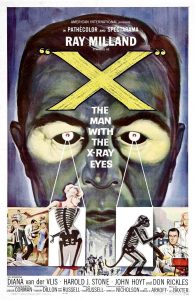
Poster for the Roger Corman film ‘The Man with the X-ray Eyes’, released in 1963. Filmaffinity.
Many other mysterious rays from the late nineteenth and twentieth centuries also attracted researchers. Some of them, such as the N-rays, discovered in the early twentieth century by a researcher from Nancy (France), Prosper-René Blondlot, 1849-1930, caused enormous interest both inside and outside the academic world. However, they were later discarded as experimental errors or biases in interpretation. Others, such as the surprising X-rays discovered by Wilhem Röntgen, made it possible to see inside opaque objects. They were soon used in medical diagnosis and reformed the visual culture of medicine, as well as diagnostic techniques for bone injuries, which also served to question certain surgical practices, both in academies and courts. While N-rays were soon forgotten, X-rays would continue their way through various academic disciplines, from medicine to nuclear physics and chemistry, and new applications would be developed in the field of industry and agriculture. For example, the possibility of irradiating seeds to cause mutations opened new frontiers in the production of new varieties, with unpredictable short and long-term consequences. In addition, Röntgen’s once mysterious rays became part of popular culture through stories and films such as Roger Corman’s ‘The Man with the X-ray Eyes’.
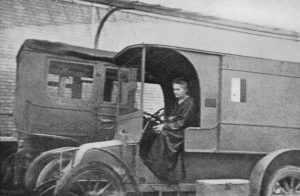
Marie Curie at the helm of an early 20th century “Petite Curie”. It was an ambulance that included X-ray diagnosis for the first time. Wikimedia.
In the field of science, X-rays were the starting point for new research on atomic structure that would lead to studies on the radioactivity of uranium salts (by authors such as Henri Becquerel) and the discovery of radium by Pierre and Marie Curie. Radioactivity presented many uncertainties and challenges because, among other issues, it questioned the principle of energy conservation on which nineteenth-century physics was based. It also opened the door to the production of a series of new phenomena that managed to transform physics in the early twentieth century. Marie Skłodowska Curie (1867-1934) would develop this research after her husband’s death until she became the only woman with two Nobel Prizes in physics and chemistry. In the first third of the twentieth century, her work allowed the development of an entire industry of radioactive applications in medicine and agriculture.
The use of radium and radioactivity spread in many areas of medicine and also agriculture. Its success even appeared in beauty creams or in mineral waters with radioactive salts. Nowadays, advertisements for cosmetic or therapeutic products using the powers of radium as an attraction would be really scaring! It should be borne in mind that the mentioned advertisements they were published before the dangerous effects of radioactivity on human health began to be known. The discovery of these risks was a complicated process, marked by many difficulties in testing and the denial of these harmful effects by the people in charge of the industries that used radioactive salts. The confirmation of health risks, along with the military use of nuclear energy that started in 1945, completely changed the public image of radioactivity.
José Ramón Bertomeu Sánchez
IILP-UV
How to cite this paper:
Bertomeu Sánchez, José Ramón. The birth of the industry of precision. Sabers en acció, 2021-01-11. https://sabersenaccio.iec.cat/en/the-birth-of-the-industry-of-precision/.
Find out more
You can find further information with the bibliography and available resources.
Recommended reading
Bowler, Peter.; Morus, Iwan. Panorama General de la Ciencia Moderna. Barcelona: Crítica, 2007.
Cahan, Daniel ed. From Natural Philosophy to the Sciences: Writing the History of Nineteenth-Century Science. Chicago: University Press; 2003.
Fara, Patricia. Breve Historia de La Ciencia. Barcelona: Ariel; 2009.
Kragh, Helge. Generaciones cuánticas: una historia de la física en el siglo XX. Madrid: Akal; 2007.
Morus, Iwan Rhys. When Physics Became King. Chicago: University of Chicago Press; 2005.
Nye, Mary J. Before Big Science. The Pursuit of Modern Chemistry and Physics 1800-1940. Cambridge: Harvard University Press; 1996.
Nye, Mary J. ed. The Cambridge History of Science. Volume 5, The Modern Physical and Mathematical Sciences. Cambridge: University Press; 2002.
Studies
Arabatzis, Theodore. 2006. Representing Electrons: A Biographical Approach to Theoretical Entities. Chicago: University of Chicago Press.
Bensaude-Vincent, Bernadette; Blondel, Christine eds. Des Savants Face à l’occulte. Paris: La Découverte; 2002.
Bertomeu Sánchez, José Ramón. La Verdad sobre el caso Lafarge. Barcelona: El Serbal; 2016.
Bertomeu Sánchez, José Ramón; García Belmar, Antonio eds. Abriendo Las Cajas Negras. Colección de Instrumentos Científicos de La Universitat de Valencia. Valencia: Universitat de València; 2002.
Bourguet, Marie et al. eds. Instruments, travel and science: Itineraries of precision. Routledge; 2002.
Brock, William H. William Crookes (1832-1919) and the Commercialization of Science. Aldershot: Ashgate; 2008.
Caneva, Kenneth L. Robert Mayer and the Conservation of Energy. Princeton: University Press; 2015.
Collins, Harry. Tacit and Explicit Knowledge. Chicago: University Press; 2010.
Curie, Marie. Biographical writings. Bellaterra: UAB; 2011.
Golan, Tal. “The Emergence of the Silent Witness: The Legal and Medical Reception of X-Rays in the USA.” Social Studies of Science. 2004;34: 469–99.
Granato, Marcus, Lourenço, Marta Lourenço (eds) Scientific instruments in the history of science: studies in transfer, use and preservation. Rio de Janeiro: Museu de Astronomia e Ciéncias Afins; 2014.
Heering, Peter; Wittje, Roland eds. Learning by Doing. Experiments and Instruments in the History of Science Teaching. Stuttgart: Franz Steiner; 2011.
Jackson, Catherine M. “The Wonderful Properties of Glass. Liebig’s Kaliapparat and the Practice of Chemistry in Glass.” Isis. 2015; 106 (1): 43–69.
Morrison-Low, Alison. Making Scientific Instruments in the Industrial Revolution. London: Ashagate; 2007.
Nye, Mary Jo. “N-rays: An episode in the history and psychology of science.” Historical Studies in the Physical Sciences, 1980; 11: 125–56.
Pestre, Dominique, ed. “Science, medicine, and industry: The Curie and Joliot-Curie laboratories.” History and Technology. 1997; 13: 241–343.
Schaffer, Simon “Machine Philosophy: Demonstration Devices in Georgian Mechanics” Osiris, 1994; 9: 157-182.
Sechner, Sara et al. How Scientific Instruments Have Changed Hands. Leiden-Boston: Brill Academic Pub; 2016.
Smith, Charles.; Wise, Norton. Energy and Empire. A Biographical Study of Lord Kelvin. Cambridge: Cambridge University Press; 1989.
Usselman, Melven et al. “Restaging Liebig: A Study in the Replication of Experiments.” Annals of Science. 2005; 62 (1): 1–55.
Weart, Spencer R. The Rise of Nuclear Fear. Cambridge: Harvard University Press; 2012.
Wise, Norton ed. The Values of Precision. Princeton: Princeton University Press; 1995.
Websites and other resources
Instruments Scientifics. Database of scientific instruments of the nineteenth and twentieth centuries. Available here.
Otto Sibum, “Entrevista sobre la replicación de experimentos científicos”. [Accessed 5 February 2019]. Available here.
Steven Turner, “Instruments for Science, 1800-1914”. Available here.



